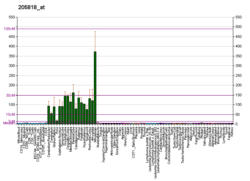DBC1
| BRINP1 | |||||||
|---|---|---|---|---|---|---|---|
| Identifiers | |||||||
| Aliases | BRINP1, DBC1, DBCCR1, FAM5A, BMP/retinoic acid inducible neural specific 1 | ||||||
| External IDs | MGI: 1928478 HomoloGene: 8754 GeneCards: BRINP1 | ||||||
| RNA expression pattern | |||||||
 | |||||||
| More reference expression data | |||||||
| Orthologs | |||||||
| Species | Human | Mouse | |||||
| Entrez | |||||||
| Ensembl | |||||||
| UniProt | |||||||
| RefSeq (mRNA) | |||||||
| RefSeq (protein) | |||||||
| Location (UCSC) | Chr 9: 119.15 – 119.37 Mb | Chr 4: 68.76 – 68.95 Mb | |||||
| PubMed search | [1] | [2] | |||||
| Wikidata | |||||||
| |||||||
Deleted in bladder cancer protein 1 is a protein that in humans is encoded by the DBC1 gene.[3][4][5][6][7]
This gene is located within chromosome 9 (9q32-33), a chromosomal region that frequently shows loss of heterozygosity in transitional cell carcinoma of the bladder. It contains a 5' CpG island that may be a frequent target of hypermethylation, and it may undergo hypermethylation-based silencing in some bladder cancers.[5]
The functions of this gene are unknown, and it has not yet been placed in a protein family or functional pathway. Nonetheless, it is suspected to act as a tumor suppressor gene.
References
- ↑ "Human PubMed Reference:".
- ↑ "Mouse PubMed Reference:".
- ↑ Habuchi T, Yoshida O, Knowles MA (Jul 1997). "A novel candidate tumour suppressor locus at 9q32-33 in bladder cancer: localization of the candidate region within a single 840 kb YAC". Hum Mol Genet. 6 (6): 913–9. PMID 9175739. doi:10.1093/hmg/6.6.913.
- ↑ Nishiyama H, Hornigold N, Davies AM, Knowles MA (Nov 1999). "A sequence-ready 840-kb PAC contig spanning the candidate tumor suppressor locus DBC1 on human chromosome 9q32-q33". Genomics. 59 (3): 335–8. PMID 10444335. doi:10.1006/geno.1999.5891.
- 1 2 "Entrez Gene: DBC1 deleted in bladder cancer 1".
- ↑ Habuchi T, Yoshida O, Knowles MA (June 1997). "A novel candidate tumour suppressor locus at 9q32-33 in bladder cancer: localization of the candidate region within a single 840 kb YAC". Hum. Mol. Genet. 6 (6): 913–9. PMID 9175739. doi:10.1093/hmg/6.6.913.
- ↑ Nishiyama H, Hornigold N, Davies AM, Knowles MA (August 1999). "A sequence-ready 840-kb PAC contig spanning the candidate tumor suppressor locus DBC1 on human chromosome 9q32-q33". Genomics. 59 (3): 335–8. PMID 10444335. doi:10.1006/geno.1999.5891.
Further reading
- Auffray C, Behar G, Bois F, et al. (1995). "[IMAGE: molecular integration of the analysis of the human genome and its expression]". C. R. Acad. Sci. III, Sci. Vie. 318 (2): 263–72. PMID 7757816.
- Habuchi T, Luscombe M, Elder PA, Knowles MA (1998). "Structure and methylation-based silencing of a gene (DBCCR1) within a candidate bladder cancer tumor suppressor region at 9q32-q33.". Genomics. 48 (3): 277–88. PMID 9545632. doi:10.1006/geno.1997.5165.
- Nishiyama H, Takahashi T, Kakehi Y, et al. (2000). "Homozygous deletion at the 9q32-33 candidate tumor suppressor locus in primary human bladder cancer.". Genes Chromosomes Cancer. 26 (2): 171–5. PMID 10469456. doi:10.1002/(SICI)1098-2264(199910)26:2<171::AID-GCC10>3.0.CO;2-B.
- Nishiyama H, Gill JH, Pitt E, et al. (2001). "Negative regulation of G(1)/S transition by the candidate bladder tumour suppressor gene DBCCR1.". Oncogene. 20 (23): 2956–64. PMID 11420708. doi:10.1038/sj.onc.1204432.
- Wright KO, Messing EM, Reeder JE (2002). "Increased expression of the acid sphingomyelinase-like protein ASML3a in bladder tumors.". J. Urol. 168 (6): 2645–9. PMID 12442002. doi:10.1097/01.ju.0000037848.19383.88.
- Strausberg RL, Feingold EA, Grouse LH, et al. (2003). "Generation and initial analysis of more than 15,000 full-length human and mouse cDNA sequences.". Proc. Natl. Acad. Sci. U.S.A. 99 (26): 16899–903. PMC 139241
 . PMID 12477932. doi:10.1073/pnas.242603899.
. PMID 12477932. doi:10.1073/pnas.242603899. - Wright KO, Messing EM, Reeder JE (2004). "DBCCR1 mediates death in cultured bladder tumor cells.". Oncogene. 23 (1): 82–90. PMID 14712213. doi:10.1038/sj.onc.1206642.
- Humphray SJ, Oliver K, Hunt AR, et al. (2004). "DNA sequence and analysis of human chromosome 9.". Nature. 429 (6990): 369–74. PMC 2734081
 . PMID 15164053. doi:10.1038/nature02465.
. PMID 15164053. doi:10.1038/nature02465. - Gerhard DS, Wagner L, Feingold EA, et al. (2004). "The status, quality, and expansion of the NIH full-length cDNA project: the Mammalian Gene Collection (MGC).". Genome Res. 14 (10B): 2121–7. PMC 528928
 . PMID 15489334. doi:10.1101/gr.2596504.
. PMID 15489334. doi:10.1101/gr.2596504. - Beetz C, Brodoehl S, Patt S, et al. (2005). "Low expression but infrequent genomic loss of the putative tumour suppressor DBCCR1 in astrocytoma.". Oncol. Rep. 13 (2): 335–40. PMID 15643521. doi:10.3892/or.13.2.335.
- Izumi H, Inoue J, Yokoi S, et al. (2005). "Frequent silencing of DBC1 is by genetic or epigenetic mechanisms in non-small cell lung cancers.". Hum. Mol. Genet. 14 (8): 997–1007. PMID 15746151. doi:10.1093/hmg/ddi092.
- Rual JF, Venkatesan K, Hao T, et al. (2005). "Towards a proteome-scale map of the human protein-protein interaction network.". Nature. 437 (7062): 1173–8. PMID 16189514. doi:10.1038/nature04209.
- Louhelainen JP, Hurst CD, Pitt E, et al. (2006). "DBC1 re-expression alters the expression of multiple components of the plasminogen pathway.". Oncogene. 25 (16): 2409–19. PMID 16369496. doi:10.1038/sj.onc.1209228.
This article is issued from
Wikipedia.
The text is licensed under Creative Commons - Attribution - Sharealike.
Additional terms may apply for the media files.